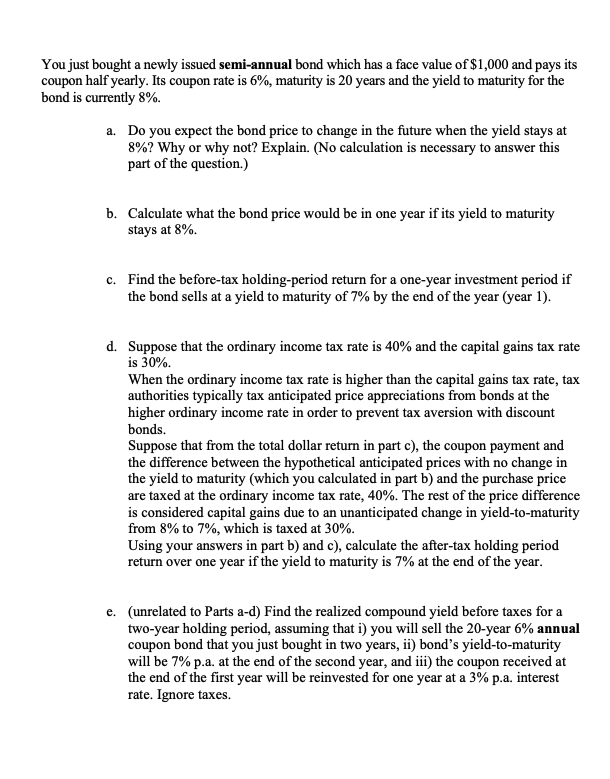Answered step by step
Verified Expert Solution
Question
1 Approved Answer
You just bought a newly issued semi-annual bond which has a face value of $1,000 and pays its coupon half yearly. Its coupon rate

You just bought a newly issued semi-annual bond which has a face value of $1,000 and pays its coupon half yearly. Its coupon rate is 6%, maturity is 20 years and the yield to maturity for the bond is currently 8%. a. Do you expect the bond price to change in the future when the yield stays at 8%? Why or why not? Explain. (No calculation is necessary to answer this part of the question.) b. Calculate what the bond price would be in one year if its yield to maturity stays at 8%. c. Find the before-tax holding-period return for a one-year investment period if the bond sells at a yield to maturity of 7% by the end of the year (year 1). d. Suppose that the ordinary income tax rate is 40% and the capital gains tax rate is 30%. When the ordinary income tax rate is higher than the capital gains tax rate, tax authorities typically tax anticipated price appreciations from bonds at the higher ordinary income rate in order to prevent tax aversion with discount bonds. Suppose that from the total dollar return in part c), the coupon payment and the difference between the hypothetical anticipated prices with no change in the yield to maturity (which you calculated in part b) and the purchase price are taxed at the ordinary income tax rate, 40%. The rest of the price difference is considered capital gains due to an unanticipated change in yield-to-maturity from 8% to 7%, which is taxed at 30%. Using your answers in part b) and c), calculate the after-tax holding period return over one year if the yield to maturity is 7% at the end of the year. e. (unrelated to Parts a-d) Find the realized compound yield before taxes for a two-year holding period, assuming that i) you will sell the 20-year 6% annual coupon bond that you just bought in two years, ii) bond's yield-to-maturity will be 7% p.a. at the end of the second year, and iii) the coupon received at the end of the first year will be reinvested for one year at a 3% p.a. interest rate. Ignore taxes. You just bought a newly issued semi-annual bond which has a face value of $1,000 and pays its coupon half yearly. Its coupon rate is 6%, maturity is 20 years and the yield to maturity for the bond is currently 8%. a. Do you expect the bond price to change in the future when the yield stays at 8%? Why or why not? Explain. (No calculation is necessary to answer this part of the question.) b. Calculate what the bond price would be in one year if its yield to maturity stays at 8%. c. Find the before-tax holding-period return for a one-year investment period if the bond sells at a yield to maturity of 7% by the end of the year (year 1). d. Suppose that the ordinary income tax rate is 40% and the capital gains tax rate is 30%. When the ordinary income tax rate is higher than the capital gains tax rate, tax authorities typically tax anticipated price appreciations from bonds at the higher ordinary income rate in order to prevent tax aversion with discount bonds. Suppose that from the total dollar return in part c), the coupon payment and the difference between the hypothetical anticipated prices with no change in the yield to maturity (which you calculated in part b) and the purchase price are taxed at the ordinary income tax rate, 40%. The rest of the price difference is considered capital gains due to an unanticipated change in yield-to-maturity from 8% to 7%, which is taxed at 30%. Using your answers in part b) and c), calculate the after-tax holding period return over one year if the yield to maturity is 7% at the end of the year. e. (unrelated to Parts a-d) Find the realized compound yield before taxes for a two-year holding period, assuming that i) you will sell the 20-year 6% annual coupon bond that you just bought in two years, ii) bond's yield-to-maturity will be 7% p.a. at the end of the second year, and iii) the coupon received at the end of the first year will be reinvested for one year at a 3% p.a. interest rate. Ignore taxes.
Step by Step Solution
★★★★★
3.47 Rating (150 Votes )
There are 3 Steps involved in it
Step: 1
a When the yield stays at 8 the bond price is not expected to change in the future This is because the yield to maturity of 8 is equal to the coupon rate of 6 indicating that the bond is priced at par ...
Get Instant Access to Expert-Tailored Solutions
See step-by-step solutions with expert insights and AI powered tools for academic success
Step: 2

Step: 3

Ace Your Homework with AI
Get the answers you need in no time with our AI-driven, step-by-step assistance
Get Started


